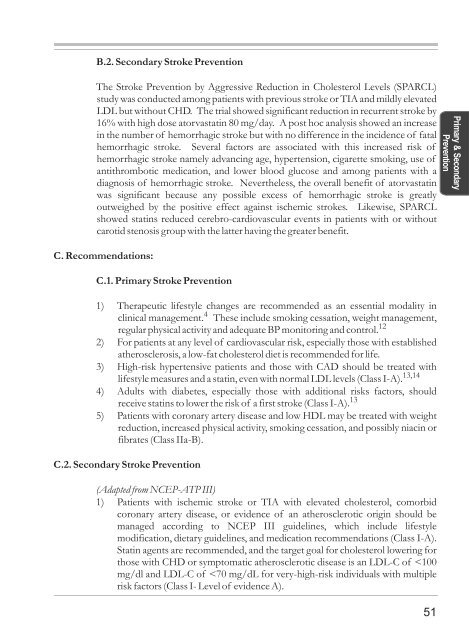Front Panel Painting “LIFE” By William T Chua MD
FREE download - Stroke Society of the Philippines
FREE download - Stroke Society of the Philippines
Create successful ePaper yourself
Turn your PDF publications into a flip-book with our unique Google optimized e-Paper software.
B.2. Secondary Stroke Prevention<br />
The Stroke Prevention by Aggressive Reduction in Cholesterol Levels (SPARCL)<br />
study was conducted among patients with previous stroke or TIA and mildly elevated<br />
LDL but without CHD. The trial showed significant reduction in recurrent stroke by<br />
16% with high dose atorvastatin 80 mg/day. A post hoc analysis showed an increase<br />
in the number of hemorrhagic stroke but with no difference in the incidence of fatal<br />
hemorrhagic stroke. Several factors are associated with this increased risk of<br />
hemorrhagic stroke namely advancing age, hypertension, cigarette smoking, use of<br />
antithrombotic medication, and lower blood glucose and among patients with a<br />
diagnosis of hemorrhagic stroke. Nevertheless, the overall benefit of atorvastatin<br />
was significant because any possible excess of hemorrhagic stroke is greatly<br />
outweighed by the positive effect against ischemic strokes. Likewise, SPARCL<br />
showed statins reduced cerebro-cardiovascular events in patients with or without<br />
carotid stenosis group with the latter having the greater benefit.<br />
C. Recommendations:<br />
C.1. Primary Stroke Prevention<br />
1) Therapeutic lifestyle changes are recommended as an essential modality in<br />
4<br />
clinical management. These include smoking cessation, weight management,<br />
regular physical activity and adequate BP monitoring and control. 12<br />
2) For patients at any level of cardiovascular risk, especially those with established<br />
atherosclerosis, a low-fat cholesterol diet is recommended for life.<br />
3) High-risk hypertensive patients and those with CAD should be treated with<br />
lifestyle measures and a statin, even with normal LDL levels (Class I-A). 13,14<br />
4) Adults with diabetes, especially those with additional risks factors, should<br />
receive statins to lower the risk of a first stroke (Class I-A). 13<br />
5) Patients with coronary artery disease and low HDL may be treated with weight<br />
reduction, increased physical activity, smoking cessation, and possibly niacin or<br />
fibrates (Class IIa-B).<br />
C.2. Secondary Stroke Prevention<br />
(Adapted from NCEP-ATP III)<br />
1) Patients with ischemic stroke or TIA with elevated cholesterol, comorbid<br />
coronary artery disease, or evidence of an atherosclerotic origin should be<br />
managed according to NCEP III guidelines, which include lifestyle<br />
modification, dietary guidelines, and medication recommendations (Class I-A).<br />
Statin agents are recommended, and the target goal for cholesterol lowering for<br />
those with CHD or symptomatic atherosclerotic disease is an LDL-C of



